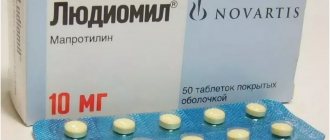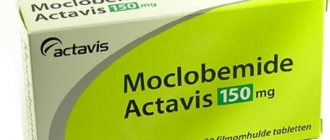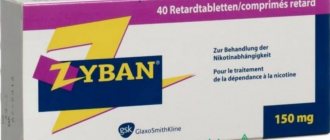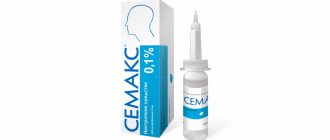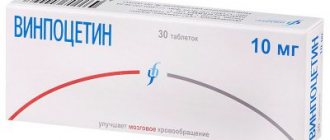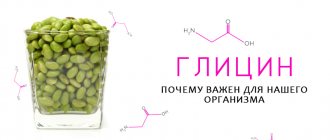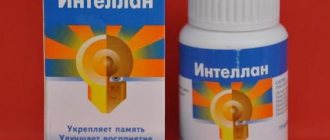Instructions for use of "Mexidol"
"Mexidol" is a drug that belongs to the pharmacological group of antihypoxants and antioxidants. The active ingredient of the product, 2-ethyl-6-methyl-3-hydroxypyridine succinate, is a derivative of aromatic polyhydric alcohols and is presented as a white, water-soluble powder.
Instructions for use of Mesquidol highlight the main pharmacological properties of the drug, presented in the table.
| Effect | Development mechanism |
| Antihypoxic | In conditions of reduced oxygen concentration in the blood, it inhibits the processes of incomplete oxidation. The absence of synthesis of under-oxidized products reduces the signs of hypoxia and increases the body's resistance to oxygen starvation. |
| Membrane stabilizing | Due to its effect on the phospholipid structures of the cell wall: it increases the activity of enzymes, the sensitivity of surface receptors and the transport system (channels for the passage of nutrients and ions). |
| Antioxidant | Inhibits lipid peroxidation under anaerobic conditions, activates the peroxide utilization system (mainly due to glutathione). |
| Neuroprotective (“protection of nerve tissue”) | Selective activity of the drug on brain cells during the process of regeneration after ischemic or traumatic injuries is noted. |
| Nootropic | Increases a person’s cognitive abilities (memory, attention, speech) after traumatic brain injury, stroke, and other neurological diseases due to:
|
| Hypolipidemic | Due to adequate utilization of fats in cells when using Mexidol, the total concentration of lipids and cholesterol in the blood decreases (anti-atherogenic effect); |
| Anxiolytic (anti-anxiety): | The effect is due to the influence on the GABAergic system with activation of the main inhibitory transmitter - gamma-aminobutyric acid |
Mexidol is used in cardiology to improve the rheological properties of blood: stabilizing the membranes of red blood cells, platelets, reducing plate aggregation and reducing the risk of thrombosis.
Composition and release form
"Mexidol" is a domestic drug that is prescribed for oral and parenteral use, therefore it exists in two forms:
- tablets of 125 mg (in packs of 30 and 50 pieces);
- solution in ampoules for intravenous or intramuscular injection (5% - 5 ml; 2% -3ml).
Comparative characteristics of the composition of the drug are shown in the table.
| Pills | Solution | |
| Active ingredient (Mexidol) | 125 mg | Ampoules of 5 ml – 50 mg/ml. Ampoules of 3 ml – 20 mg/ml. |
| Excipients |
|
|
| Organoleptic properties | White round tablets without division strip | Transparent colorless solution, without impurities |
The specifics of prescribing a particular form and dosage of the drug depend on the specific pathology and severity of the patient’s condition.
Indications: what does it help with?
The wide range of effects of Mexidol determines the list of indications for prescribing the drug in practice:
- recovery period of acute cerebrovascular accident, traumatic brain injury or spinal injury;
- hemorrhagic stroke and cerebral infarction;
- post-traumatic epilepsy;
- complex therapy of multiple sclerosis, parkinsonism;
- senile dementia (to slow progression);
- mild to moderate cognitive impairment;
- acute intoxication with neuroleptic drugs (“Aminazine”, “Haloperidol” and others);
- polyneuropathy (diabetic, traumatic origin);
- ophthalmopathy and corneal pathology after laser intervention;
- open angle glaucoma;
- rehabilitation for opium drug addiction, alcoholism;
- discirculatory encephalopathy - disorders of metabolic processes in neurons against the background of a general somatic disease (for example, diabetes mellitus);
- acute withdrawal syndrome;
- vibration disease is an occupational pathology characterized by a generalized dysregulation of vascular tone.
In cardiology, Mexidol is prescribed to patients with coronary heart disease (CHD) and arterial hypertension. The drug increases the therapeutic effect of antihypertensive drugs and improves the subjective well-being of patients: reduction of dizziness, pain in the back of the head, rapid heartbeat due to arrhythmias.
Oral administration
The official instructions for Mexidol in tablet form highlight a list of conditions in which the use of the drug is justified:
- complex treatment of IHD functional class II-III;
- hypertonic disease;
- migraine attacks in adults;
- vegetative-vascular dystonia (VSD) according to the hypertensive variant;
- cognitive disorders in patients taking alcohol for a long time;
- outpatient stage of rehabilitation of neurological patients;
- prevention of panic attacks in patients with phobias and anxiety conditions;
- insomnia.
The selection of an effective dose is determined by the individual characteristics of the patient and averages 250-500 mg/day. The duration of therapy with oral forms of Mexidol is at least 2 months.
Intramuscular and intravenous administration
Parenteral use of the drug is prescribed in a neuropsychiatric hospital, therapy department or cardiology department. The dose and frequency of intramuscular and intravenous use of Mexidol for various pathologies is presented in the table.
| Disease | Dose, frequency of administration | Course duration |
| Acute intoxication with alcohol or antipsychotics (the drug accelerates the removal of toxic metabolites from the body) | 50-300 mg/day | 7-14 days |
| Dyscirculatory, post-traumatic encephalopathy | 100 mg 2-3 times a day | 14 days |
| Acute pancreatitis | 100 mg 3 times/day | 7-10 days |
| Pancreatic necrosis |
| 10-14 days |
| Early period after stroke, brain or spinal cord injury with cognitive, anxiety disorders |
| 10-14 days |
| Acute withdrawal syndrome in alcoholism | 100-200 mg 2 times a day | 5-7 days |
| Open angle glaucoma | Intramuscularly 100 mg 3 times/day | 14 days |
Parenteral use of Mexidol is limited to short courses of up to 2 weeks (for encephalopathy - up to 4).
Instructions for use of Mexiprim (analogue) require discontinuation of the drug for 2-3 days with a gradual reduction in dose. The consequence of abrupt cessation of use is “rebound syndrome” with increased manifestations of the underlying disease.
Rules for administering and taking the drug
The effectiveness of the drug is determined by the adequacy of the dose and method of administration. According to the annotation, the oral form is prescribed 1 tablet 2-3 times a day, washed down with a sufficient amount of clean water, regardless of meals.
Rules for parenteral administration of Mexidol:
- intramuscular injections: 2-3 times a day in the upper-outer part of the buttock;
- intravenous use: bolus (slowly the entire dose without dilution over 5-7 minutes), drip (speed 40-60 drops/minute).
When consumed on an empty stomach, nausea, discomfort in the stomach, and decreased blood sugar levels may occur, so doctors recommend taking Mexidol 30 minutes after eating.
Is it necessary to dilute the drug before administration?
Intravenous drip (infusion) administration of Mexidol is used to create a stable concentration of active metabolites in the blood plasma (for an infusion period of 2-3 hours).
The most commonly used standard solvents in the clinic are:
- 0.9% sodium chloride solution (physiological);
- 5% glucose solution in bottles of 200 and 400 ml.
For drip administration, the drug is dissolved in the ratio: 100 mg (2 ml of 5% Mexidol) - 200 ml of solution.
Maintaining a constant concentration of the drug in the blood promotes a longer-lasting effect with the possibility of gradual adaptation of the body to new metabolic conditions.
Side effects and symptoms of overdose
Mexidol belongs to the group of metabolic antioxidant agents that are available in pharmacies with a prescription.
The beginning of treatment in 10-15% of patients is accompanied by the development of side effects:
- allergic reactions (itching rash, swelling, redness in the injection area);
- dry mouth;
- nausea;
- discomfort in the upper abdomen (stomach, duodenum);
- sweating palms and feet;
- drowsiness;
- impaired coordination (the drug is not recommended for patients whose profession requires constant concentration);
- increased heart rate;
- lability of blood pressure.
If adverse reactions occur from taking the drug, you must stop using it and inform your doctor.
Contraindications for taking Mexidol:
- allergic reactions to any of the components of the product;
- acute liver and kidney failure (the drug is excreted mainly in the urine);
- children under 18 years of age, women during pregnancy and breastfeeding (no clinical data on safety).
In case of overdose, severe drowsiness, slow reaction, high or low blood pressure, and dizziness are noted. Treatment of intoxication with Mexidol is infusion therapy in the intensive care unit.
Indications for use
The drug is indicated for use in a number of cases:
- neurological pathologies;
- chronic cerebrovascular diseases;
- cerebrovascular accident;
- vegetative-vascular dystonia (mixed type);
- cardiac ischemia (as an additional remedy);
- brain hypoxia;
- problems with memory, attention, speech;
- constant stress;
- skull injuries;
- glaucoma;
- alcoholism;
- poisoning with neuroleptics;
- increased anxiety.
The use of Mexidol for parkinsonism
Parkinsonism (Parkinson's disease) is a neurological pathology that is characterized by a progressive decrease in the amplitude and accuracy of movements, against the background of which tremor (shaking) of the limbs develops. Most often, the disease is diagnosed in older people (over 55 years old).
The morphological basis of the disease is associated with a violation of the synthesis of dopamine, a mediator of nerve impulses, in the substantia nigra of the brain. Standard treatment for pathology involves the use of replacement therapy with active precursors of the substance.
Long-term use of such drugs contributes to metabolic disorders in neurons, which is manifested by the synthesis of free radicals and damage to the cell membrane. An integrated approach using antihypoxic agents additionally affects peripheral structures and improves metabolism in the brain.
Clinical studies using Mexidol in the treatment of Parkinson's disease noted:
- increasing the speed of impulse transmission along the nerve (during a study on an electroneuromyograph);
- reducing the manifestations of tremor (oscillations) and increasing the amplitude of movements;
- increased efficiency and the possibility of reducing the dose of basic antiparkinsonian drugs (illustrated using the example of Cyclodol);
- reduction in the severity of symptoms (unsteadiness of gait, tremors in the hands, stiffness of movements) according to the Hen-Yahru scale;
- an increase in the concentration of dopamine metabolic products in the blood (results of an experimental study at the Center for Extrapyramidal Diseases).
As part of complex therapy, Mexidol is recommended for patients with Parkinson's disease at a dose of 200-400 mg/day in the form of a dropper (4-8 ml of a 5% solution of the drug per 250-300 ml of saline).
Mexidol tablets: description of the drug
The drug is available in the form of tablets that are taken orally and a solution for injection (injections are given both intramuscularly and into a vein). The active substance in both cases is ethylmethylhydroxypyridine in the form of succinate (125 mg in 1 tablet).
The product is a synthetic antioxidant that destroys free radicals - dangerous molecules that destroy cells. Due to this, a number of positive effects are observed:
- saturation of cells with oxygen;
- improvement of circadian rhythm;
- improved sleep;
- protection of lipid complexes;
- reduction of oxidative reactions;
- increased performance;
- improvement of metabolic processes;
- reduction of cholesterol in the blood.
The drug can only be purchased with a prescription. Store it in normal room conditions at a temperature of no more than 25 degrees. The place should be dark, without direct sunlight. The shelf life is 3 years from the date of production.
Features of application at low pressure
The decrease in blood pressure when taking Mexidol is due to increased synthesis and accumulation of natriuretic peptide, which promotes the removal of sodium salts and water from the body (diuretic effect).
The moderate hypotensive effect of the drug requires careful use in patients with low levels of:
- at values of 110/70-90/60 – it is allowed to take a standard dose of Mexidol;
- less than 90/60 – consultation with a specialist is required about the advisability of prescribing the drug and the need for pressure correction.
For mild hypotension, Mexidol is recommended due to its ability to normalize the autonomic innervation of the vascular wall and increase indicators to optimal values.
Drug interactions: the drug enhances the effect of antihypertensive drugs (beta-blockers, diuretics), therefore it is prescribed with caution to patients with mild hypertension.
Contraindications and side effects
In some cases, taking the drug is excluded:
- chronic kidney disease;
- liver dysfunction;
- individual intolerance to the active or auxiliary component;
- children under 15 years of age inclusive;
- pregnancy period (any stages);
- breastfeeding period.
The use of Mexidol can lead to some side effects:
- nausea, vomiting;
- itching;
- sleep disorders;
- increased fatigue;
- diarrhea;
- depression;
- high blood pressure;
- anxiety;
- migraine.
In these cases, the pills or injections should be stopped immediately. It is necessary to seek the advice of a specialist - perhaps the doctor will decide to replace the drug.
How often can the course of treatment be repeated?
Mexidol is a drug that is used to systemically improve cellular metabolic processes. Experts recommend taking the product regularly, in short or medium-duration courses:
- 10-14 days - every 2 months;
- 6 weeks - once every 6-12 months.
It is always prohibited to use Mexidol due to addiction and reduced effectiveness of the drug. For long-term correction of oxidative processes in the body, the use of other means is recommended during the pause.
Where to buy Mexidol: price, reviews
The product can be bought in pharmacies at a price of 250 rubles for a package of 30 tablets or 450 rubles for 10 ampoules with a solution of 50 mg/ml. If you study customer reviews, you can see that the drug is very popular - the drug is recommended by more than 80% of patients.
Among the advantages are efficiency, reasonable price, and completely reliable information in the instructions. Many buyers write that their headaches, dizziness and other unpleasant sensations have gone away. In some cases, they talk about the lack of treatment results and the occurrence of side effects.
Analogues and domestic substitutes
The domestic manufacturer offers patients many analogues - products that differ in name and cost: Mexiprim, Neurox, Astrox, Meksifin, Neurocard, Proinin.
Complex therapy in an inpatient clinic for neurological and cardiovascular diseases is accompanied by the use of antioxidants and other agents that improve metabolism.
The drugs most used in clinical practice are:
- nootropics (to improve cognitive abilities, accelerate metabolic processes in the brain): Piracetam, Pantogam, Bifren, Noofen, Cerebrolysin;
- “Actovegin” is a product made from dried calf blood extract, which increases tissue resistance to hypoxia, improves metabolic processes, and accelerates the healing of ulcers and wounds;
- "Mydocalm" is a drug used in neurology for the treatment of diseases with increased muscle tone (multiple sclerosis, parkinsonism), postoperative and traumatic contractures;
- "Meldonium" ("Mildronate") is a universal metabolic agent that is used in cardiology to restore the myocardium after a heart attack;
- vitamin preparations with antioxidant and neuroprotective effects: “Milgamma” (group B complex), “Aevit” (A+E).
Autonomic disorders caused by compression of nerve roots due to osteochondrosis require complex therapy:
- diuretics (“Furosemide”);
- nonsteroidal anti-inflammatory drugs (“Voltaren”, “Diclofenac”);
- muscle relaxants - to relax spastic back muscles (Mydocalm, Baclofen).
To relieve headaches, doctors recommend drugs with proven effectiveness - Spazmalgon, Ibuprofen.
Analogues of "Mexidol"
Mexidol analogues include a number of prescription and over-the-counter drugs:
- "Glycine":
- "Cerekard";
- "Neurox";
- "Combiplen";
- "Caviton";
- "Hypoxen";
- "Armandine";
- "Tenoten";
- Astrox;
- "Tryptophan";
- Rilutek and many others.
The most popular analogues of Mexidol tablets are:
- "Armadin" - also available in the form of solution and tablets. They are more expensive - for example, tablets can be purchased for at least 300 rubles, ampoules for injections - from 500 rubles. The medicine is taken to improve memory, especially in older patients. The product also helps improve performance and does not cause drowsiness.
- “Glitsed” is a sedative drug that can be purchased at a price of 900 rubles. Improves blood supply to the brain, helps with recovery from traumatic brain injuries, and is used to treat a number of diseases of the nervous system.
- “Antifront” is a blood pressure stabilizer that helps cope with headaches and dizziness. The price starts from 1500 rubles.
- "Actovegin" is often prescribed in parallel with "Mexidol" because it has the same properties.
conclusions
Mexidol is a drug from the group of antioxidant nootropic drugs, which is widely used in medical practice for the complex treatment of acute and chronic disorders. A competent approach to prescribing and checking for compatibility with other medications is the key to the effectiveness of treatment. There is no evidence base for monotherapy with Mexidol, so independent use of the drug for diagnosed neurological diseases is accompanied by the risk of progression of the pathology and a worsening prognosis for the patient’s life.
Dosage
Mexidol can be used as a drug for intravenous, intramuscular and oral administration.
- If a drug, from which injections into the muscle are painful, is administered intramuscularly, dosages should be from 2 to 4 ml per day (the latter option is better divided into two injections).
- A dosage of 4 to 6-8 ml diluted in saline is used intravenously.
- Tablet forms should be started with 1-2 tablets twice a day, gradually the dosage can be increased to a maximum of 8 tablets per day.
The duration of therapy should be at least two weeks.
Price for tablets and ampoules
The price can vary greatly depending on the city of residence, and even more so on the pharmacy (despite the fact that the drug is included in the list of vital and essential drugs).
On average, the price of Mexidol varies within the following limits (price relevance as of 12/18/14):
- Tablets, package No. 30. 215-250 rubles.
- Tablets, package No. 50. 340-390 rubles.
- Injections 2 ml, package No. 10. 410-480 rubles.
- Injections 2 ml, package No. 50. 1750-2000 rubles.
- Injections 5 ml, package No. 5. 400-470 rubles.
- Injections 5 ml, package No. 20. 1380-1530 rubles.
Reviews from people
Vera Lapteva
:
For us personally, Mexidol simply turned out to be a savior after a stroke. Firstly, speech returned, and secondly, a clear consciousness began to appear. I can only say positive things about this drug.
Olga Yanina
:
My close friend suffered a stroke.. This sight is not for the faint of heart... Rehabilitation took more than a year. Among other things, Mexidol was used as a restorative therapy - it seemed to me that the effect of the drug was good and my health improved - at least a visible effect. Although it is understandable, the initial condition of the patient and the attention of loved ones, their support and care are important.
Ekaterina Kostyuchenko
:
I completely agree with what was written above that Mexidol is indispensable in the treatment and rehabilitation after a stroke. It helped my aunt with the restoration of speech and reduction of hand tremors, and her memory became clearer. The main thing is to prescribe it in time, the sooner after a stroke, the more effective, before irreversible processes have time to develop. And of course, family support is of no small importance in rehabilitation; we did not leave my aunt alone for a minute.

